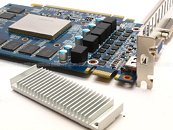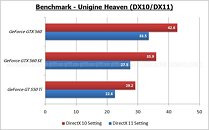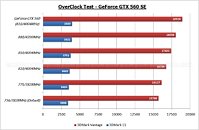- Joined
- Oct 9, 2007
- Messages
- 47,449 (7.50/day)
- Location
- Hyderabad, India
| System Name | RBMK-1000 |
|---|---|
| Processor | AMD Ryzen 7 5700G |
| Motherboard | ASUS ROG Strix B450-E Gaming |
| Cooling | DeepCool Gammax L240 V2 |
| Memory | 2x 8GB G.Skill Sniper X |
| Video Card(s) | Palit GeForce RTX 2080 SUPER GameRock |
| Storage | Western Digital Black NVMe 512GB |
| Display(s) | BenQ 1440p 60 Hz 27-inch |
| Case | Corsair Carbide 100R |
| Audio Device(s) | ASUS SupremeFX S1220A |
| Power Supply | Cooler Master MWE Gold 650W |
| Mouse | ASUS ROG Strix Impact |
| Keyboard | Gamdias Hermes E2 |
| Software | Windows 11 Pro |
Even as NVIDIA is inching towards the launch of its next-generation GeForce GTX 670 Ti, it is rushing out the GeForce GTX 560 SE to stem loss in competitiveness to the Radeon HD 7770. Galaxy is readying a compact, cost-effective graphics card based on the new GPU, which is pictured below. Based on the 40 nm GF114 GPU (variant: GF114-200-KB-A1), the GTX 560 SE features 288 CUDA cores, 48 TMUs, 24 ROPs, and a 192-bit wide GDDR5 memory interface, holding 1 GB [(4x 1 Gbit)+(2x 2 Gbit)] of GDDR5 memory.
Galaxy's card uses a short PCB, its VRM area has been pushed to the front of the card, consisting of a 4+1 phase design. It draws power from two 6-pin power connectors. The card is cooled by a compact aluminum-fin heatsink to which heat is conveyed by copper heat pipes, and ventilated by a big (80 mm) fan. Chinese site QK123 put the card through a few synthetic benchmarks, measured power-draw, and OC performance. The GPU-Z screenshot reveals its reference speed.




Benchmarks follow.
Benchmarks included 3DMark 11 (performance preset), 3DMark Vantage (performance preset), Unigine Heaven (both DX10 and DX11 renderer modes). The card was pitted against the GeForce GTX 560 (non-Ti), and the GeForce GTX 550 Ti, two cards that are its immediate neighbours in NVIDIA's lineup. In all synthetics tests, the GeForce GTX 560 SE sits halfway of the performance difference between GTX 560 and GTX 550 Ti, which is in tune with NVIDIA's objective behind this SKU.


Moving on to power-consumption, the GTX 560 SE card from Galaxy has a slightly higher idle power draw than the GTX 560, which can be discounted for random variation. Its heavy-load power draw (load induced by Furmark), is slightly below the GTX 550 Ti, which again can be discounted for variation. The load power is 17% lower than that of the GTX 560 (non-Ti), which is significant, and can be attributed to the lack of two GDDR5 memory chips, among other factors such as fewer CUDA cores, etc.

Moving on to OC performance scaling, the reviewer increased the clock speed in fairly fine increments of core and memory clocks in alternative steps. The performance scaling was found to be fairly linear.

Overall, NVIDIA has a decent option in the sub-$200 segment, looking at this data alone.
View at TechPowerUp Main Site
Galaxy's card uses a short PCB, its VRM area has been pushed to the front of the card, consisting of a 4+1 phase design. It draws power from two 6-pin power connectors. The card is cooled by a compact aluminum-fin heatsink to which heat is conveyed by copper heat pipes, and ventilated by a big (80 mm) fan. Chinese site QK123 put the card through a few synthetic benchmarks, measured power-draw, and OC performance. The GPU-Z screenshot reveals its reference speed.




Benchmarks follow.
Benchmarks included 3DMark 11 (performance preset), 3DMark Vantage (performance preset), Unigine Heaven (both DX10 and DX11 renderer modes). The card was pitted against the GeForce GTX 560 (non-Ti), and the GeForce GTX 550 Ti, two cards that are its immediate neighbours in NVIDIA's lineup. In all synthetics tests, the GeForce GTX 560 SE sits halfway of the performance difference between GTX 560 and GTX 550 Ti, which is in tune with NVIDIA's objective behind this SKU.


Moving on to power-consumption, the GTX 560 SE card from Galaxy has a slightly higher idle power draw than the GTX 560, which can be discounted for random variation. Its heavy-load power draw (load induced by Furmark), is slightly below the GTX 550 Ti, which again can be discounted for variation. The load power is 17% lower than that of the GTX 560 (non-Ti), which is significant, and can be attributed to the lack of two GDDR5 memory chips, among other factors such as fewer CUDA cores, etc.

Moving on to OC performance scaling, the reviewer increased the clock speed in fairly fine increments of core and memory clocks in alternative steps. The performance scaling was found to be fairly linear.

Overall, NVIDIA has a decent option in the sub-$200 segment, looking at this data alone.
View at TechPowerUp Main Site
Last edited:









